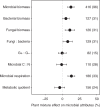Meta-analysis shows positive effects of plant diversity on microbial biomass and respiration
- PMID: 30902971
- PMCID: PMC6430801
- DOI: 10.1038/s41467-019-09258-y
Meta-analysis shows positive effects of plant diversity on microbial biomass and respiration
Abstract
Soil microorganisms are key to biological diversity and many ecosystem processes in terrestrial ecosystems. Despite the current alarming loss of plant diversity, it is unclear how plant species diversity affects soil microorganisms. By conducting a global meta-analysis with paired observations of plant mixtures and monocultures from 106 studies, we show that microbial biomass, bacterial biomass, fungal biomass, fungi:bacteria ratio, and microbial respiration increase, while Gram-positive to Gram-negative bacteria ratio decrease in response to plant mixtures. The increases in microbial biomass and respiration are more pronounced in older and more diverse mixtures. The effects of plant mixtures on all microbial attributes are consistent across ecosystem types including natural forests, planted forests, planted grasslands, croplands, and planted containers. Our study underlines strong relationships between plant diversity and soil microorganisms across global terrestrial ecosystems and suggests the importance of plant diversity in maintaining belowground ecosystem functioning.
Conflict of interest statement
The authors declare no competing interests.
Figures





References
Publication types
MeSH terms
Substances
LinkOut - more resources
Full Text Sources

